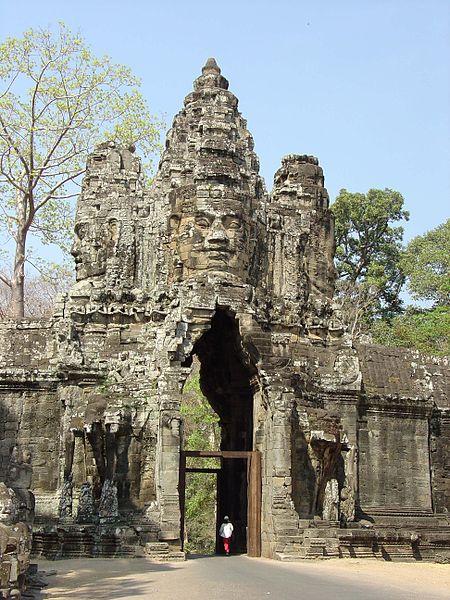


|

Face TowerSouth Gate, Angkor Thom |
The gate is notable for four large faces, carved upon its tower, which overlook the four cardinal directions. Many more such faces appear upon the towers of the Bayon itself, and also upon the towers of other temples built by Jayavarman. This photo was taken from the south, just outside the gate, which is the main entrance to the royal city.
Interpretation of these face-towers continues to exercise the minds of scholars and visitors alike; they are one of the great icons of Angkor. Most scholars (Thierry Zephir is an exception) believe that the faces resemble Jayavarman VII himself, whose features are known from several free-standing statues. Since the Khmers traditionally carved statues of the gods with the facial features of the king, this amounts to saying that the faces represent Jayavarman as identified with some particular god. Authors differ on which god this might be. Since Jayavarman was a Buddhist, one possible identification would be Avalokiteshvara, the Bodhisattva of Compassion (Coe p.124, Freeman and Jacques p.76; see also the Avalokiteshvara Pediment in the Bayon.) Another possibility is Brahma, the Hindu god with four directional faces who is said by Buddhists to have received Buddha's teaching in the Trayastrimsha Heaven. On the other hand, Zephir (p.90) believes that the faces represent four Mahayana Buddhist directional guardians. Finally, note the tricephalic elephants on either side of the doorway (next page). This is Airavata, the mount of Indra, suggesting yet another identification of the tower faces as Jayavarman assimilated to Indra, who is the king of gods as Jayavarman is the king of men.
Whether the tower faces represent Avalokiteshvara or some other deity, there seems to be general (although not unanimous) agreement that the features are Jayavarman's, and that the face-tower symbolism involves Jayavarman as a great protector, compassionately watching over and guarding his kingdom.

|

|

|